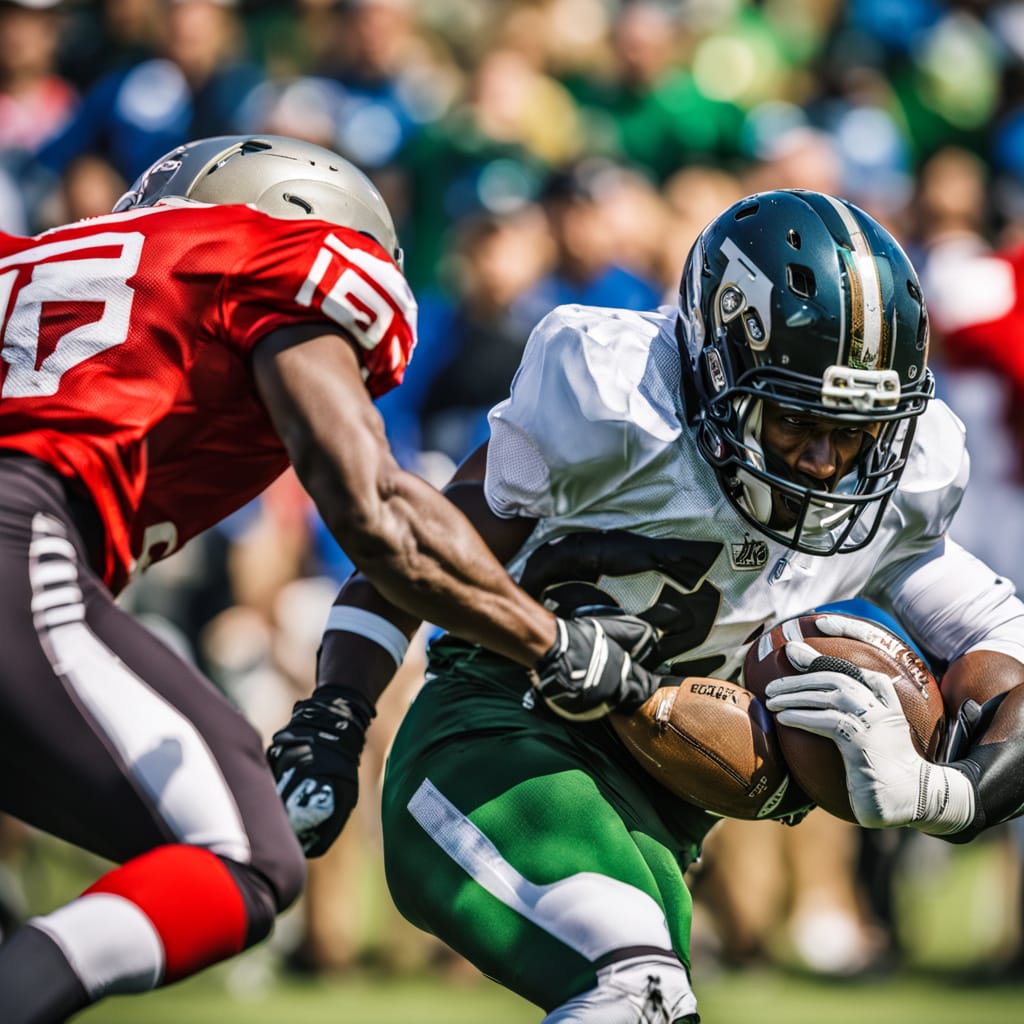Football Defenses
Football Defenses: Understanding Schemes, Strategies, and Innovations

Football defenses play a crucial role in determining the outcome of any game. While offenses often receive much of the attention due to high-scoring plays, a strong defense can dictate the pace of a game and frustrate even the most skilled offensive units. Understanding defensive strategies is key to appreciating the nuances of the sport. Whether it’s a zone defense or a man-to-man defense, the objective remains the same: limit the opposing offense’s ability to move the ball and score. In this blog, we’ll explore the difference between zone and man-to-man defenses, break down the types of each, and dive into the impact of analytics on defensive strategies. We’ll also examine what the future holds for football defenses as innovations continue to evolve.
The Difference Between Zone Defense and Man-to-Man Defense
At the heart of any defensive strategy in football lies the decision between using zone defense or man-to-man defense. These two approaches offer distinct advantages and challenges, which teams leverage depending on the situation, personnel, and opposition.
Zone Defense
In a zone defense, each defensive player is responsible for covering a specific area of the field, or “zone,” rather than tracking an individual offensive player. The primary focus is to keep offensive players out of these zones and limit the amount of space available for passes. Defenders must remain aware of their surroundings, switching responsibilities when offensive players move through their assigned zones.
Man-to-Man Defense
Conversely, man-to-man defense assigns each defender to cover a specific offensive player. The defender’s responsibility is to follow their assigned man wherever they go on the field. Their job is to maintain close coverage to disrupt passes and prevent big plays. Man-to-man defense requires defenders to be highly skilled at shadowing their opponent and reacting quickly to cuts, speed changes, and routes.
Types of Zone Football Defenses
Zone defenses can be categorized into several variations, depending on how many players are assigned to different zones and how much field coverage is desired. Each type has unique characteristics that offer strengths in different game situations.
1. Cover 2
Cover 2 is one of the most commonly used zone defenses in football. It involves two safeties, each responsible for one-half of the deep portion of the field. The cornerbacks and linebackers cover the underneath zones, typically breaking the field into five short areas. This scheme is effective at limiting deep throws and forcing the offense to settle for short passes. The corners and linebackers play a critical role in preventing big plays on short routes.
However, the major weakness of a Cover 2 zone is the middle of the field, just behind the linebackers and in front of the safeties. A well-timed throw between these zones can exploit this gap, especially if the offense runs vertical routes to stretch the safeties.
2. Cover 3
Cover 3 divides the field into three deep zones, each covered by one defender. Typically, the two cornerbacks and a single safety handle these deep areas, while the remaining defenders focus on short or medium zones. This defense offers more protection against the deep ball than Cover 2 because there is one extra deep defender. It also allows the team to stack the box more efficiently against the run.
The downside of Cover 3 is that it leaves open areas on the sidelines between the shallow zones and the deep zones. Quick, accurate passes to these regions can expose the defense. Additionally, offenses may exploit the single safety in deep coverage, especially with speedier receivers.
3. Cover 4 (Quarters Defense)
In a Cover 4 defense, the deep part of the field is split into four zones, each covered by a cornerback or safety. This defense is particularly effective against deep passes, as each defender has less space to cover vertically. It’s a great defense when the opponent faces long-yardage situations, where the likelihood of a deep pass is high.
One significant drawback of Cover 4 is its vulnerability to the running game. With so many defenders focused on the deep portions of the field, offenses can exploit gaps in the defense with power runs or quick throws underneath.
4. Cover 6 (Quarter-Quarter-Half Defense)
Cover 6 is a hybrid defense that combines elements of Cover 2 and Cover 4. One side of the field plays a Cover 4, while the other side uses a Cover 2. This mix gives the defense more versatility in its approach to defending different offensive looks. Teams often use Cover 6 to provide extra deep coverage on one side of the field while defending shorter routes more aggressively on the other.
The main weakness of Cover 6 is that it can be predictable. Once offenses identify which side of the defense is playing Cover 2 versus Cover 4, they can attack the side where the coverage is more vulnerable to their play design.
Types of Man-to-Man Football Defenses
While zone defenses are focused on guarding space, man-to-man defenses revolve around one-on-one matchups. There are several ways to employ man-to-man schemes, depending on the skillsets of both the defensive players and the offensive threats they face.
1. Press Man
Press man defense involves defenders lining up directly in front of the offensive players they are responsible for covering. The goal is to use physicality at the line of scrimmage to disrupt the timing of the receiver’s route. The defender jams the receiver at the snap and then sticks with them throughout their route. This style is most effective with cornerbacks who have both speed and strength to handle physical receivers.
However, press man coverage comes with significant risks. If a receiver breaks free from the initial jam, they may gain a substantial lead on the defender. Teams with fast or agile receivers can exploit this coverage with quick slants or deep routes if the press fails.
2. Off-Man Coverage
In off-man coverage, the defender gives the receiver space by lining up several yards off the line of scrimmage. This approach allows the defender to react to the receiver’s movements while keeping the play in front of them. Off-man coverage is effective against offenses that rely on short, quick throws, as defenders can close in on the ball more quickly.
The downside of off-man coverage is that it allows receivers to gain momentum and make quick cuts before the defender can react. Additionally, if the defender misjudges the receiver’s speed or direction, big plays can result.
3. Robber Technique
The robber technique is a variation of man-to-man defense where one safety, often the “robber,” has the freedom to roam. This safety reads the quarterback and breaks on the ball when it is thrown, often jumping into passing lanes to intercept the ball or break up the play. While the other defenders are locked into their man assignments, the robber helps double-cover the most threatening offensive player or disrupt passes over the middle.
However, the robber technique can leave other areas of the field vulnerable. If the roaming safety guesses wrong or is out of position, the offense can take advantage of the open spaces.
4. Combo Coverage
In combo coverage, a team employs both man-to-man and zone principles in the same play. For example, a defense might have its cornerbacks play man coverage on the outside receivers while the safeties and linebackers cover zones in the middle of the field. This versatility allows defenses to adapt to the specific strengths of the offense and disguise their intentions more effectively.
The challenge with combo coverage is communication. Players must be highly aware of each other’s assignments, ensuring they don’t leave open gaps in coverage. If defenders miscommunicate, it can lead to blown assignments and big plays for the offense.
Pros and Cons of Zone Football Defenses
Like any strategy, zone defenses have their strengths and weaknesses.
Pros of Zone Defense
- Flexibility: Zone defense allows defenders to keep their eyes on the quarterback, making it easier to read plays and jump on interceptions.
- Cover Multiple Receivers: Zone coverage can help limit the effectiveness of offenses that rely on multiple passing threats.
- Tackling: Defenders are often in better positions to make tackles after the catch since they are facing the ball.
Cons of Zone Defense
- Exploitable Gaps: Zone defenses leave open spaces that skilled quarterbacks and route runners can exploit.
- Less Pressure on Receivers: Since defenders are focusing on areas rather than individuals, wide receivers can sometimes find more space to operate.
- Requires Communication: Zone defenses rely heavily on communication between defenders. A breakdown can lead to easy completions or even big plays.
Pros and Cons of Man-to-Man Football Defenses
Man-to-man defenses, while simpler in concept, come with their own set of advantages and disadvantages.
Pros of Man-to-Man Defense
- Aggressiveness: Defenders can play more physically against receivers, disrupting their routes and timing.
- No Easy Completions: Quarterbacks must make pinpoint throws to avoid tight coverage.
- Flexibility Against Passes: Man coverage works well against offenses that rely on quick passes to the outside.
Cons of Man-to-Man Defense
- Vulnerability to Mismatches: If an offensive player is significantly more athletic than the defender, man coverage can be exploited.
- Fatigue: Man-to-man defense requires a great deal of energy, as defenders must shadow their assigned player constantly.
- Less Vision of the Field: Since defenders focus on their assigned man, they may lose track of the ball or miss opportunities for turnovers.
The Role of Analytics in Defensive Strategy
Analytics have transformed football, including how teams approach defense. By analyzing tendencies, success rates, and player performance, defenses can adapt more effectively to specific opponents. Advanced metrics like expected points added (EPA), coverage success rates, and tackling efficiency provide teams with a deeper understanding of their strengths and weaknesses.
For example, a team might analyze data showing that a particular quarterback struggles against Cover 3 but excels against Cover 2. As a result, the defense may adjust its game plan to exploit that weakness. Player tracking data also offers insight into how much ground defenders cover, how quickly they react, and how successful they are in various defensive schemes.
Future Innovations in Football Defenses
Football defenses will continue to evolve as analytics, technology, and player skillsets advance. One possible innovation involves the increasing use of positionless players. These versatile defenders, capable of playing multiple positions, will allow teams to create more complex and unpredictable defensive schemes.
Additionally, as offenses rely more on mobile quarterbacks and spread formations, defenses may adapt with more hybrid schemes that combine the best elements of zone and man-to-man coverage. We could also see more sophisticated uses of artificial intelligence in game planning, where algorithms predict offensive tendencies and suggest defensive adjustments in real-time.
Another future trend is enhanced player monitoring. Wearable technology that tracks movement, heart rate, and fatigue levels will help coaches make real-time adjustments, ensuring players remain at peak performance throughout the game. This data can inform substitution patterns and determine optimal defensive rotations.
Conclusion
Football defenses are the backbone of any successful team. The choice between zone defense and man-to-man defense often depends on a variety of factors, including the opponent’s strengths, game situation, and available personnel. Both defensive schemes have their merits and drawbacks, and understanding them is crucial for appreciating the strategy behind the game. As analytics and technology continue to advance, defenses will evolve, becoming more adaptable and precise. In the ever-changing world of football, defenses must remain one step ahead of offenses, innovating and adjusting to meet the demands of the modern game.






